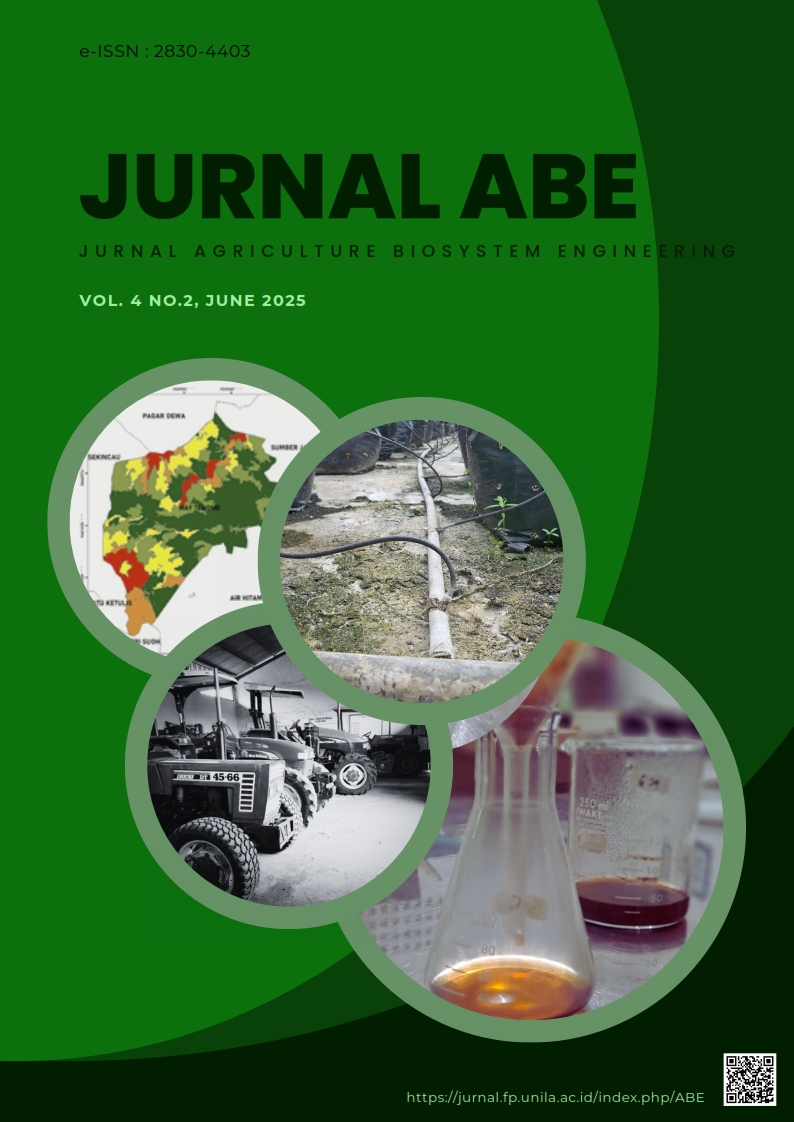Aplikasi Filtrasi Arang Sekam dan Arang Kayu terhadap Perubahan Parameter Fisika dan Kimia Limbah Domestik
DOI:
https://doi.org/10.23960/jabe.v4i3.11908 Abstract View: 94
Abstract View: 94
Keywords:
Domestic Wastewater, Filtration, Rice Husk Charcoal, Water Quality, Wood CharcoalAbstract
Domestic wastewater pollution poses serious threats to public health and the environment, as it contains pollutants such as suspended solids, organic matter, ammonia, and dissolved substances that often exceed quality standards. Simple and low-cost treatment methods are therefore needed to improve wastewater quality before discharge. This study analyzed the quality of domestic wastewater before and after filtration using rice husk charcoal and wood charcoal as filter media. The observed parameters included physical indicators (temperature, TSS, TDS) and chemical indicators (pH, COD, BOD, NH₃). Filtration improved several physical parameters: TSS decreased, pH shifted closer to neutral, and temperature remained within the permissible deviation. In contrast, chemical parameters such as COD and BOD increased after treatment, likely due to the release of organic compounds from the charcoal media. Ammonia concentration also rose but stayed below the regulatory limit. Compared with the water quality standards of Lampung Province Regulation No. 11 of 2012 (Category I), only a few parameters met the requirements, particularly the physical indicators. Overall, rice husk and wood charcoal show potential as simple and inexpensive filter media for improving physical parameters of domestic wastewater. However, their effectiveness in reducing organic pollutants is limited, and integration with other treatment methods is recommended.
Downloads
References
Agrawal, V.R., Vairagade, V.S., & Kedar, A.P. (2017). Activated Carbon as Adsorbent In Advance Treatement of Wastewater. IOSR Journal of Mechanical and Civil Engineering (IOSR-JMCE). 14(4) 36-40.
Akeli, M.W.O.C., Potalangi, N.O., Untu, S.D., Tumbel, S.L. (2020). Fitoremediasi tumbuhan Eceng Gondok dan Apu-Apu Terhadap Air Limbah Pabrik Pengolahan Tepung Kelapa PT. Royal Coconut Gorontalo. Jurnal majalah Info Sains. 1(1) 1-10.
Das, S., Mishra, S., & Sahu, H. (2023). A review of activated carbon to counteract the effect of iron toxicity on the environment. Environmental Chemistry and Ecotoxicology, 5, 86-97.
Kuswoyo, A., & Ulimaz, A. (2022). Pengaruh Jenis dan Ketebalan Karbon Aktif pada Sistem Constructed Wetlands untuk Pengolahan Limbah Cair Rumah Tangga. Bioscientist: Jurnal Ilmiah Biologi, 10(1), 173-181.
Martini, S., Yuliwati, E., & Kharismadewi, D. (2020). Pembuatan Teknologi Pengolahan Limbah Cair Industri. Jurnal Distilasi, 5(2), 26-33.
Nababan, D., Ester, M., Sitorus, J., Elisabeth, I., Etalia, N., & Brahmana, B. (2019). Kemampuan Biofilter Anaerob Berdasarkan Jenis Media dalam Pengolahan Air Limbah Domestik Tahun 2016. Jurnal Riset Hesti Medan Akper Kesdam I/BB Medan 4(2), 105–11.
Nainggolan, A. A., Arbaningrum, R., Nadesya, A., Harliyanti, D. J., & Syaddad, M. A. (2019). Alat Pengolahan Air Baku Sederhana Dengan Sistem Filtrasi. Widyakala Journal, 6(1), 12-20.
Purwoto, S., & Nugroho, W. (2013). Removal klorida, TDS dan besi pada air payau melalui penukar ion dan filtrasi campuran zeolit aktif dengan karbon aktif. WAKTU: Jurnal Teknik UNIPA, 11(1), 47-59.
Putra, A. Y., & Mairizki, F. (2020). Penentuan Kandungan Logam Berat Pada Air Tanah Di Kecamatan Kubu Babussalam, Rokan Hilir, Riau. Jurnal Katalisator, 5(1), 47-53.
Ratnawati, R., & Kholif, M. Al. (2018). Aplikasi Media Batu Apung Pada Biofilter Anaerobik Untuk Pengolahan Limbah Cair Rumah Potong Ayam. Jurnal Sains dan Teknologi Lingkungan. 10(72), 1–14.
Zhang, X., Guo, W., Ngo, H. H., Wen, H., Li, N., & Wu, W. (2016). Performance evaluation of powdered activated carbon for removing 28 types of antibiotics from water. Journal of Environmental Management, 172, 193-200.
Downloads
Published
How to Cite
Issue
Section
License
Copyright (c) 2025 Azril Refanzah, Mareli Telaumbanua, Elhamida Rezkia Amien, Sugeng Triyono

This work is licensed under a Creative Commons Attribution-NonCommercial-ShareAlike 4.0 International License.
Authors who publish with this journal agree to the following terms:
Authors retain copyright and grant the journal right of first publication with the work simultaneously licensed under a Creative Commons Attribution-ShareAlike 4.0 International Lice that allows others to share the work with an acknowledgement of the work's authorship and initial publication in this journal.
Authors are able to enter into separate, additional contractual arrangements for the non-exclusive distribution of the journal's published version of the work (e.g., post it to an institutional repository or publish it in a book), with an acknowledgement of its initial publication in this journal.
Authors are permitted and encouraged to post their work online (e.g., in institutional repositories or on their website) prior to and during the submission process, as it can lead to productive exchanges, as well as earlier and greater citation of published work (See The Effect of Open Access).
Jurnal Agricultural Biosystem Engineering

JABE is licensed under a Creative Commons Attribution-ShareAlike 4.0 International License.




